Which Kind Of Food Do Dogs (Or Any Animal) Prefer Best Science Fair Project
Dog food preference experiment:
Do dogs adopt pricier foods?
- 1. The trouble
- 2. The experiment
- 3. The chart
- 4. Conclusions
- 5. Charting lawmaking
1. The problem:
Every calendar week we go and buy nutrient for our canis familiaris. Julie, our 5.5 year old yellow lab is a very picky eater who doesn't like dog food very much. She greatly prefers human food. Nosotros have spent a lot of money over the years trying unlike kinds of dog food. Some of it was pretty expensive, but we never made the toll a gene in what to purchase. We wanted Julie to have the best food. Nosotros wanted her to be both healthy and happy.
The more expensive nutrient, so "the web" told us, has less filler, and more healthy ingredients. This may exist then, only if Julie herself could talk and tell us which food she prefers, we felt nosotros would have another valuable data-signal.
We decided to do a uncomplicated experiment and expose Julie at the same time to different kinds of nutrient and so she can tell usa which one she prefers. As a twist to make the experiment more than interesting we decided to tape non merely her preference, simply besides the price-per-pound for each food we give her.
two. The experiment:
We bought four brands of food. Each meal was divided in 4-parts and served on iv separate plates, one plate per brand.
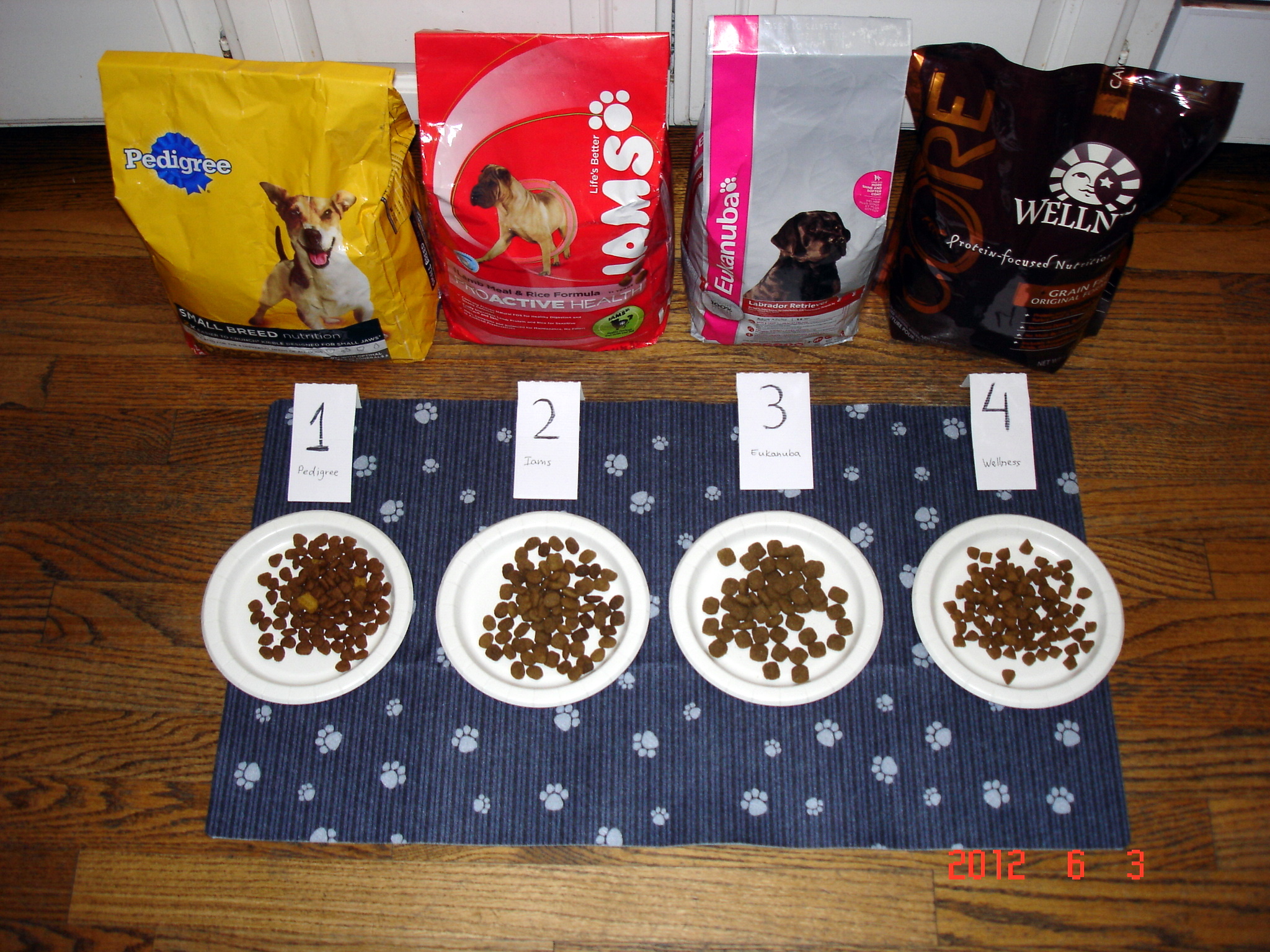
Preparing for the 1st experiment: the 4 brands in 4 plates
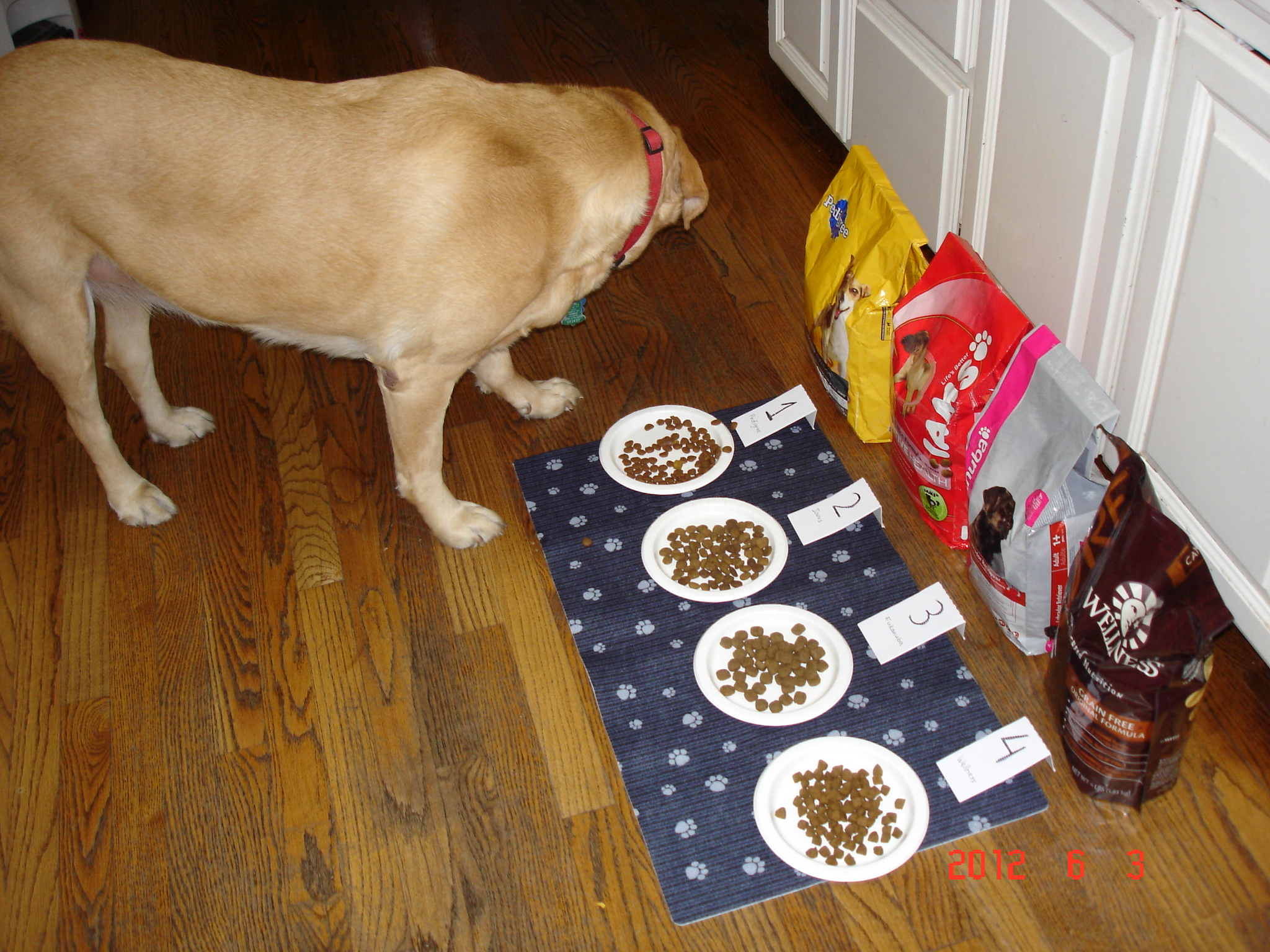
1st experiment: Julie checks the food
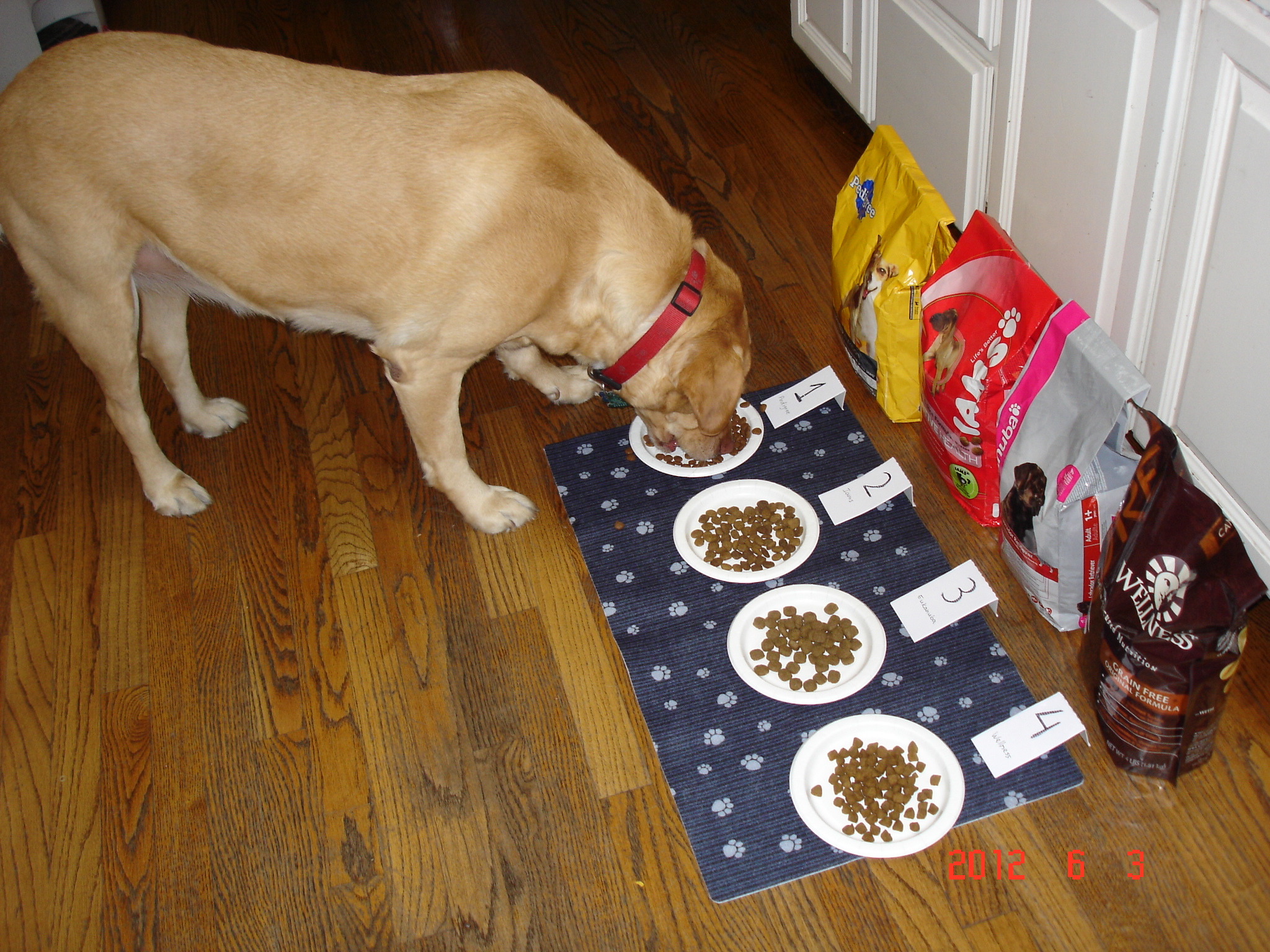
1st experiment: Julie eats in her preferred order
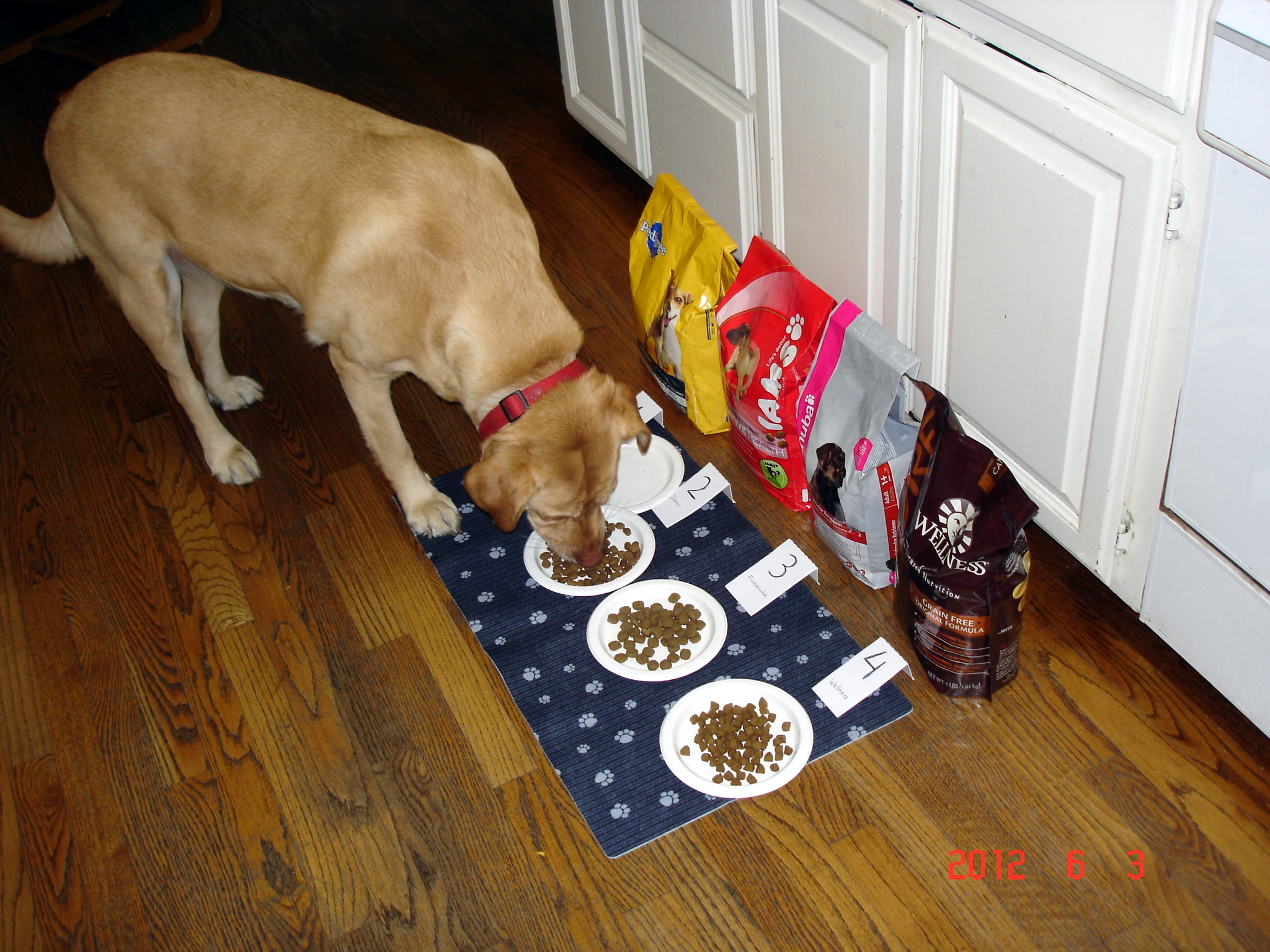
1st experiment: Julie eats in her preferred order
Before each meal we shuffled the order of the plates randomly and wrote down the order in which Julie decided to swallow them: From iv (most preferred, eaten first) to 1 (least-preferred, eaten last) Note that the numeric labels (1,2,3,4) are identifiers for the brands, there's no relation between them and the 'preference' lodge although both use the aforementioned 4 numbers.
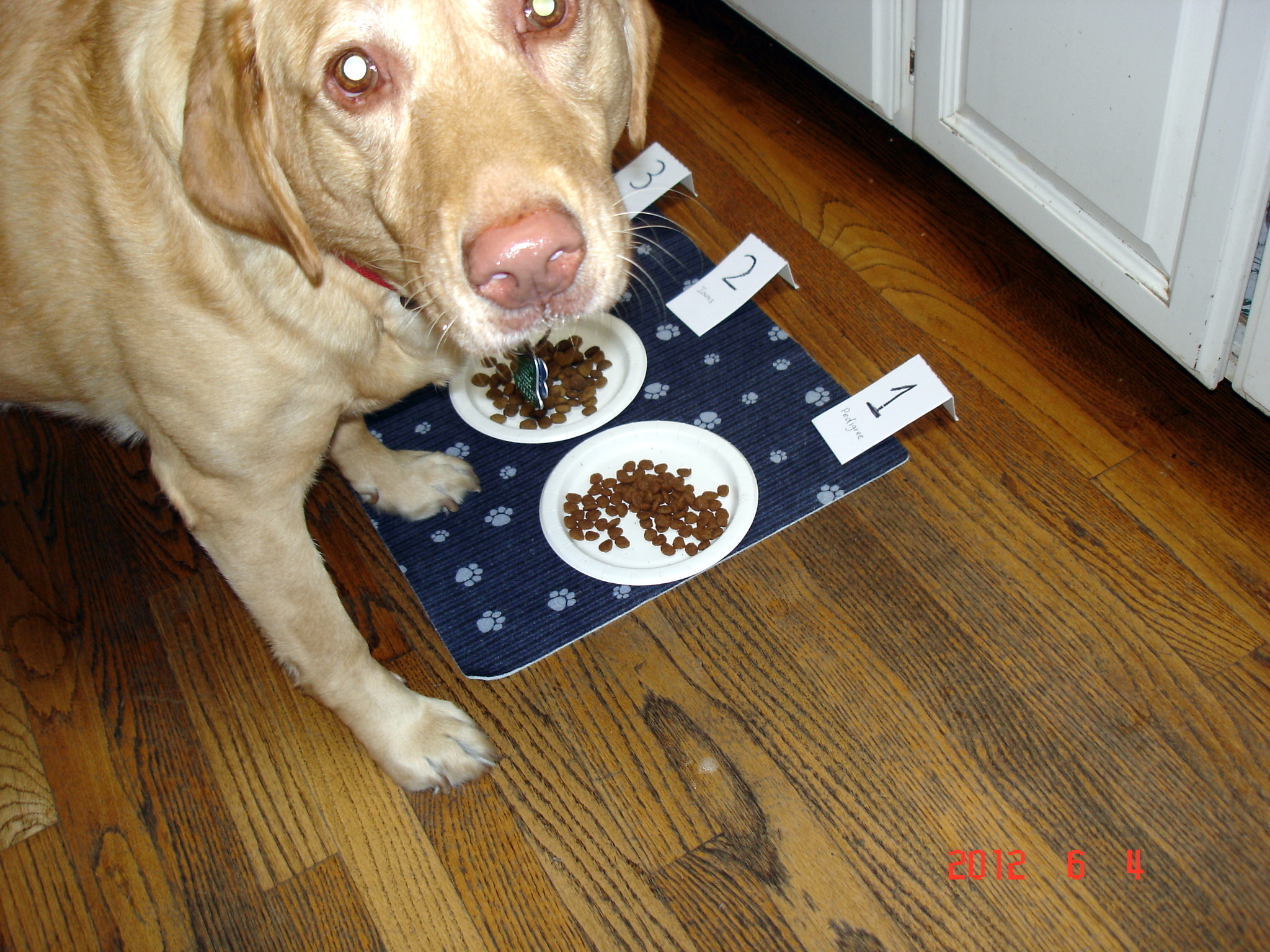
2nd experiment: bags gone, society shuffled
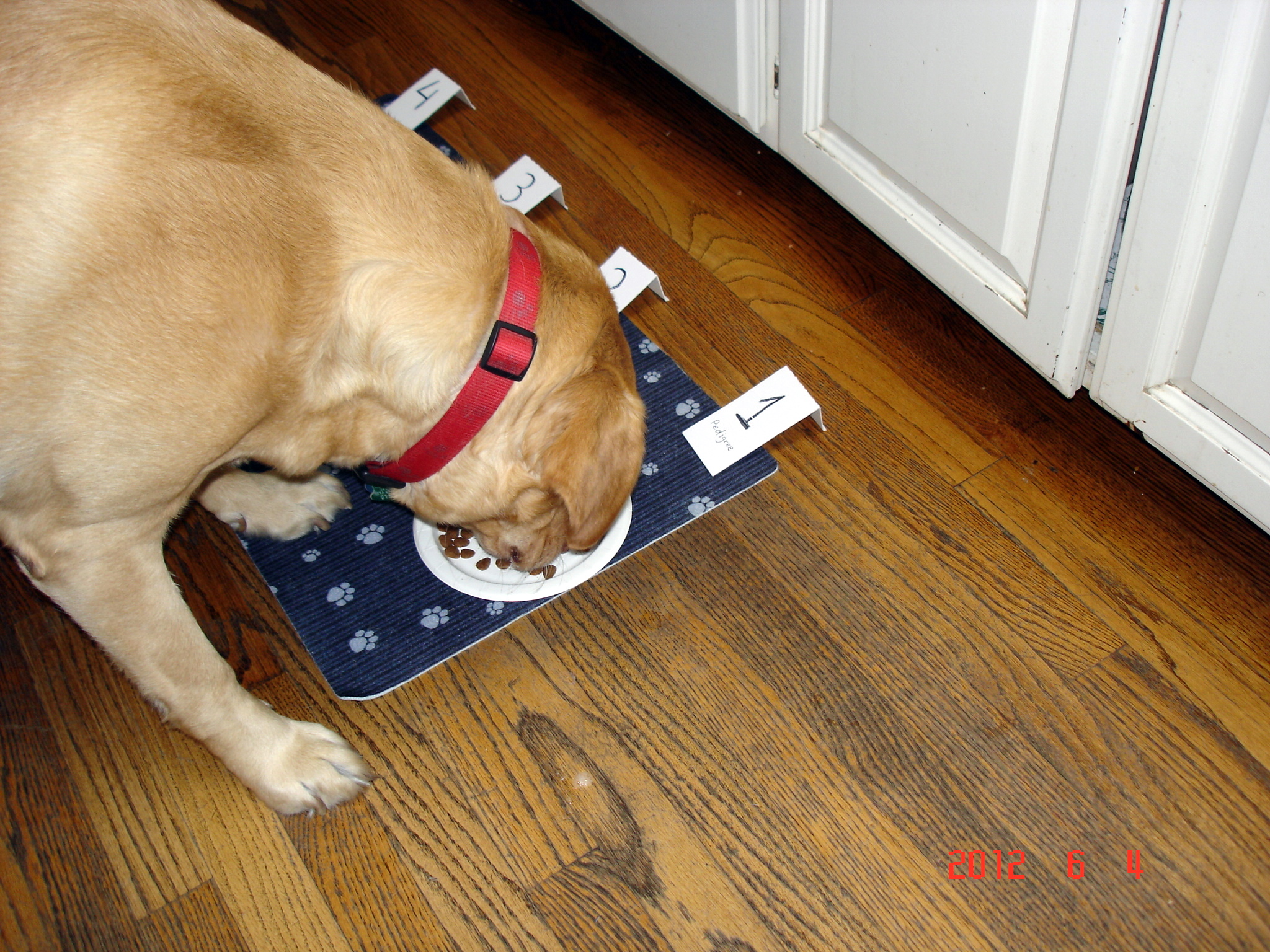
second experiment: Julie eats in her preferred lodge
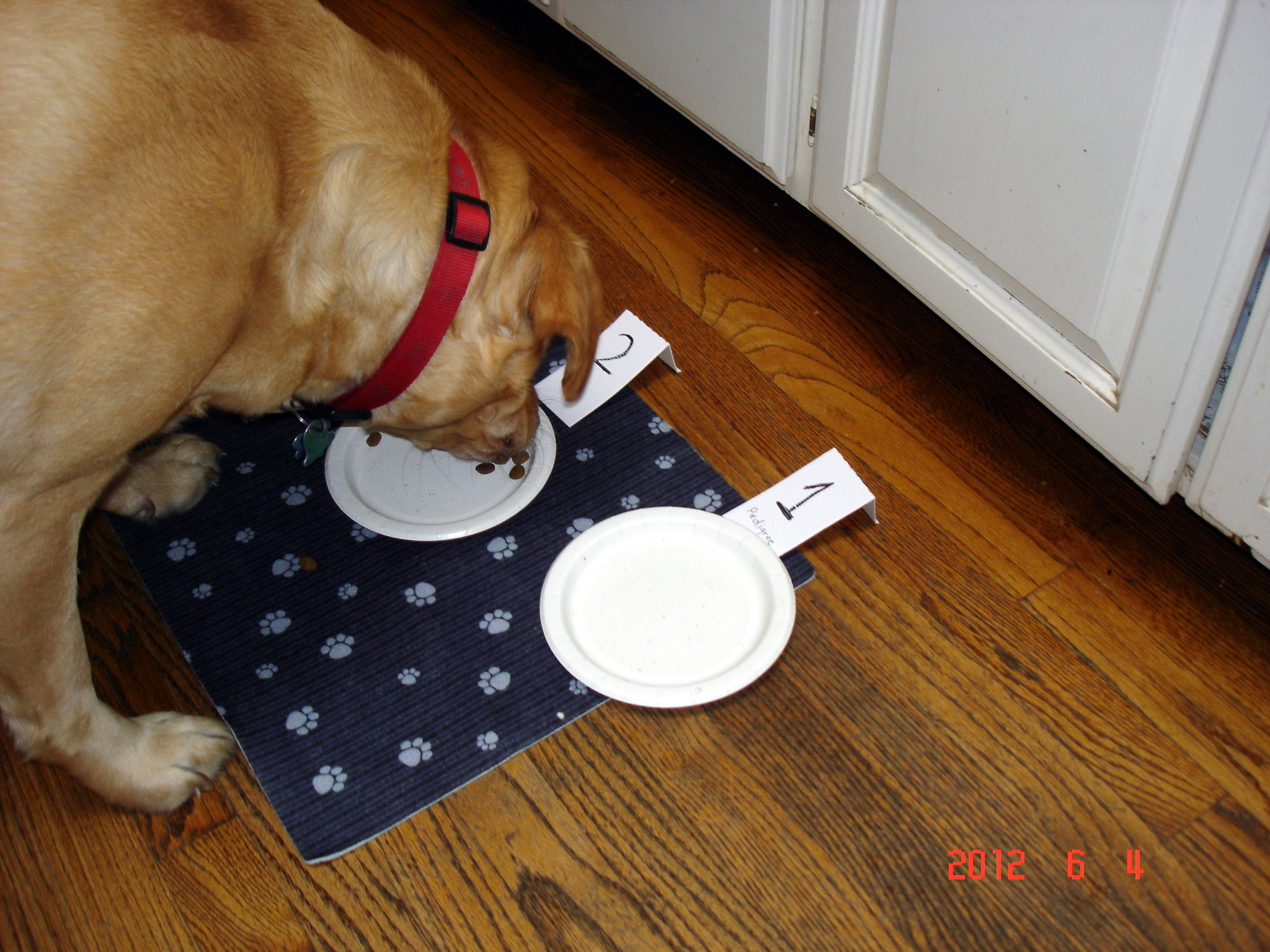
2d experiment: Julie eats in her preferred order
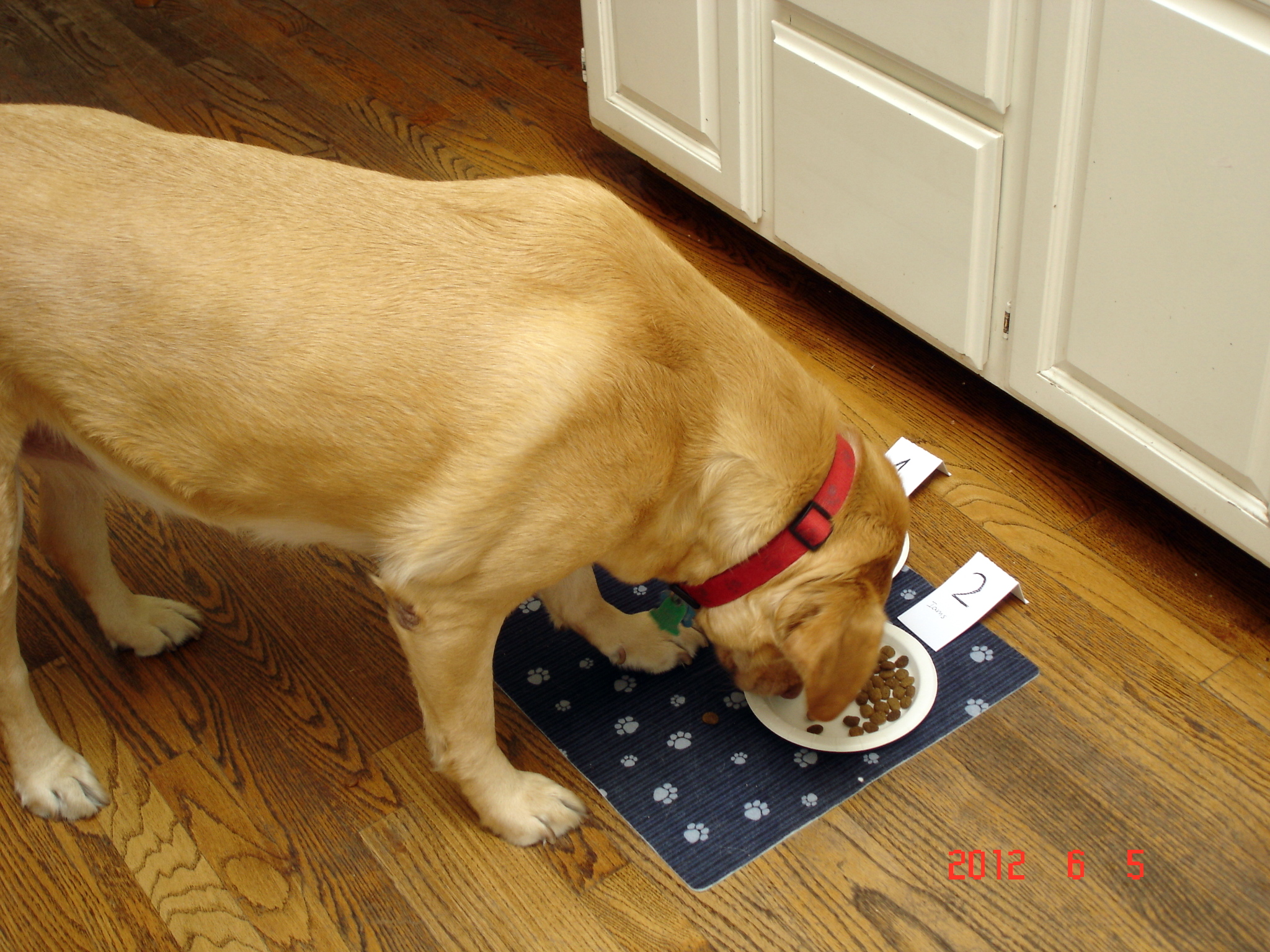
4th experiment: 1 and 2 are first to be eaten
Information technology is hard to see this in the photo considering Julie's head is blocking the view of 3 of the plates (labeled 1, 4, and 3). Simply once again, Julie started from the one labeled '1', even though it was in the eye, preferring to go on with the one labeled '2' and so movement to the left for the terminal two plates (iv, and 3).
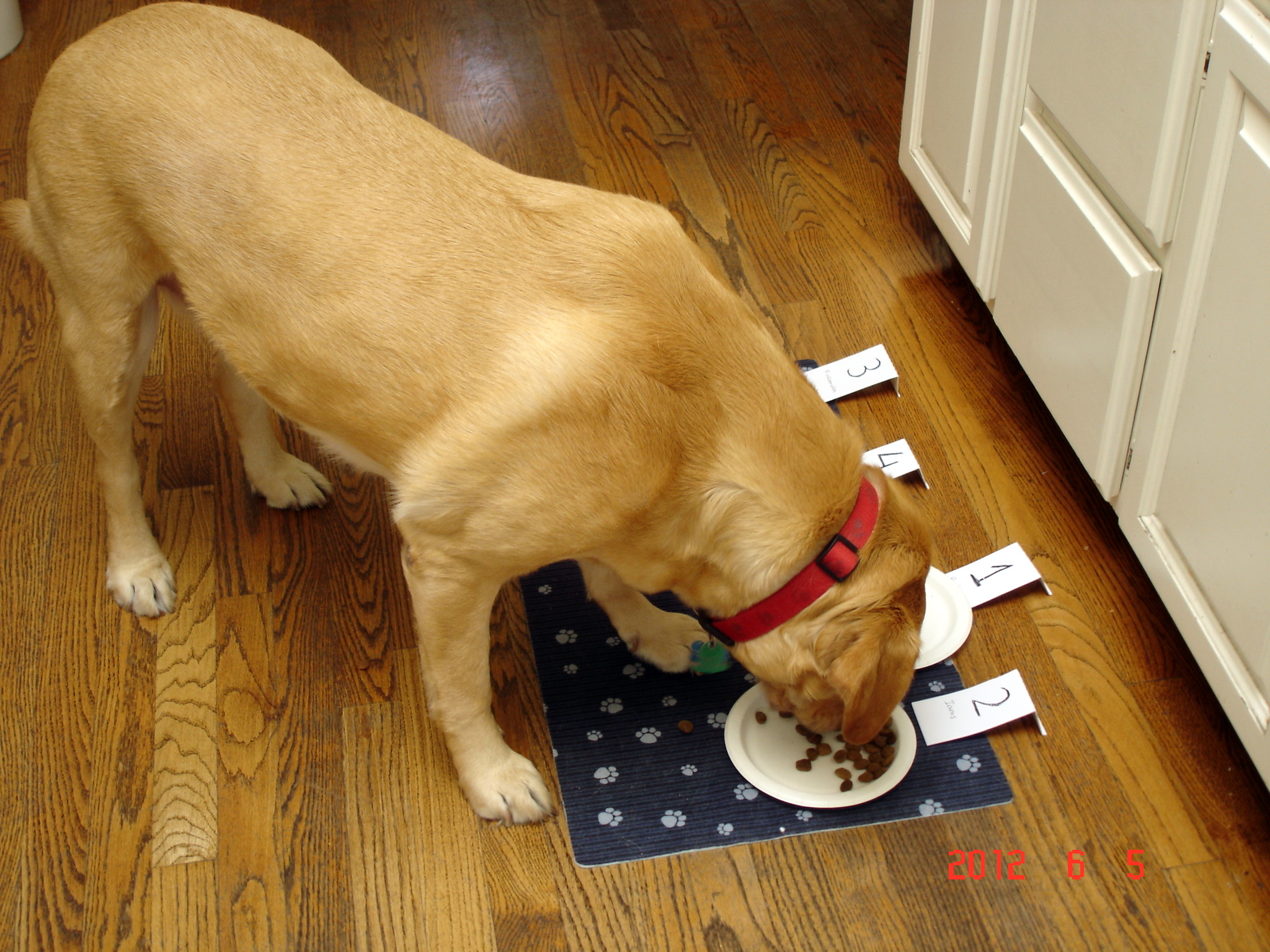
fourth experiment: 1 and 2 are first to be eaten
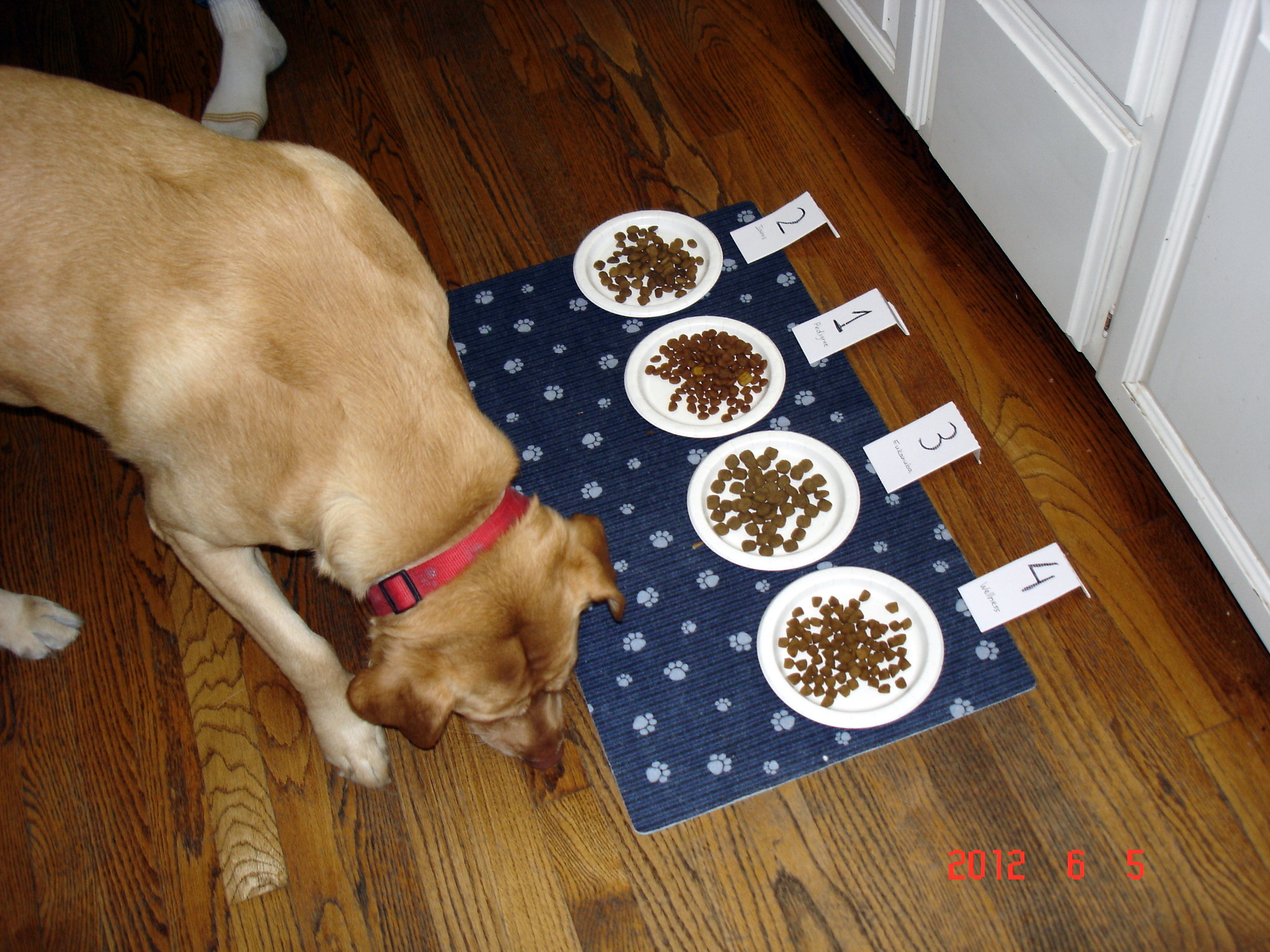
5th experiment: nevertheless deciding where to start
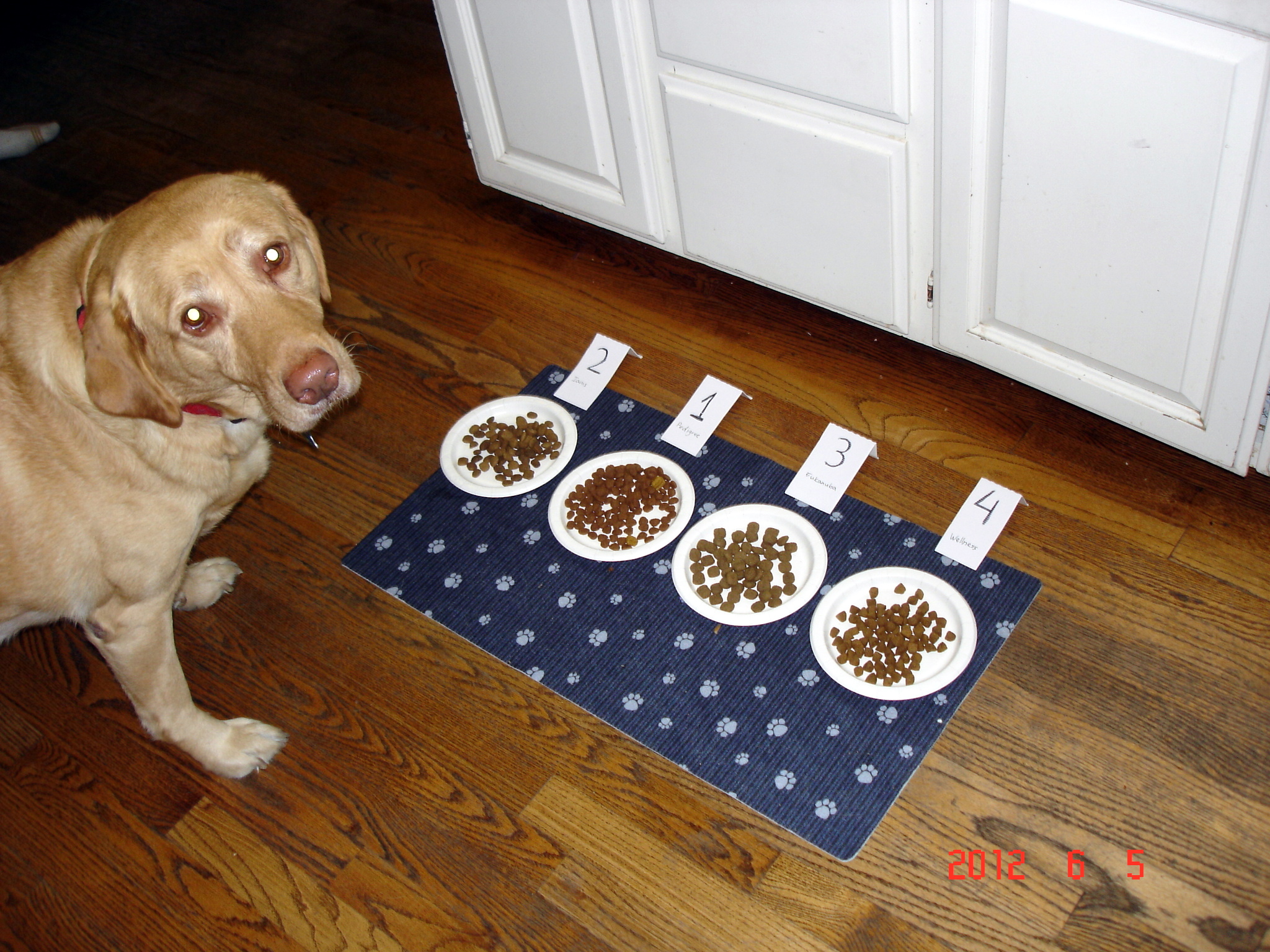
fifth experiment: nevertheless deciding where to first
After five meals we had this tabular array. The concluding number is the hateful of the preference-scores beyond all experiments:
Make,weight,cost,meal1,meal2,meal3,meal4,meal5,preference "1: Full-blooded",4.4,half-dozen.99,4,four,three,four,four,iii.8 "two: Iams",6.1,13.49,iii,3,four,three,i,2.8 "iii: Eukanuba",4.0,14.99,2,two,two,1,3,two.0 "4: Wellness",4.0,19.99,1,ane,iii,two,1,one.vi
Here'due south the experiment raw data, rendered in a more readable fashion:
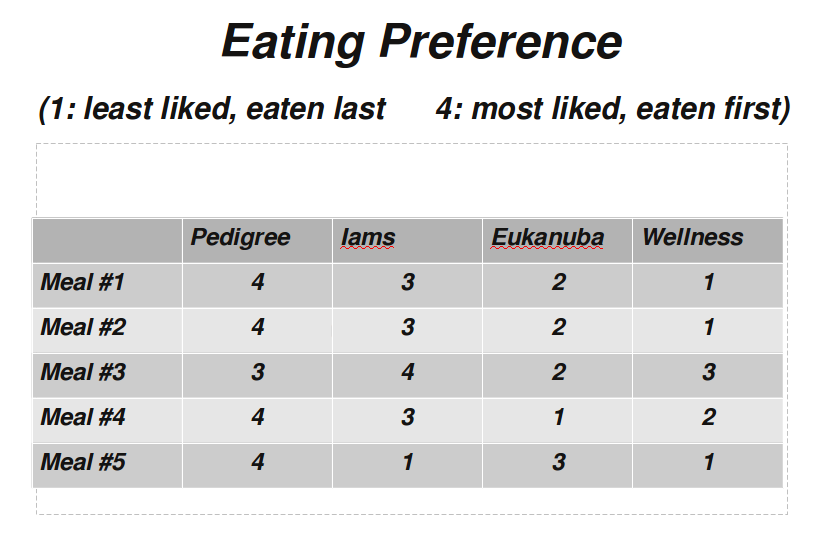
3. The Nautical chart (click to enlarge):
Using Hadley Wickham'southward wonderful R/ggplot2 library we generated the post-obit chart from the data: 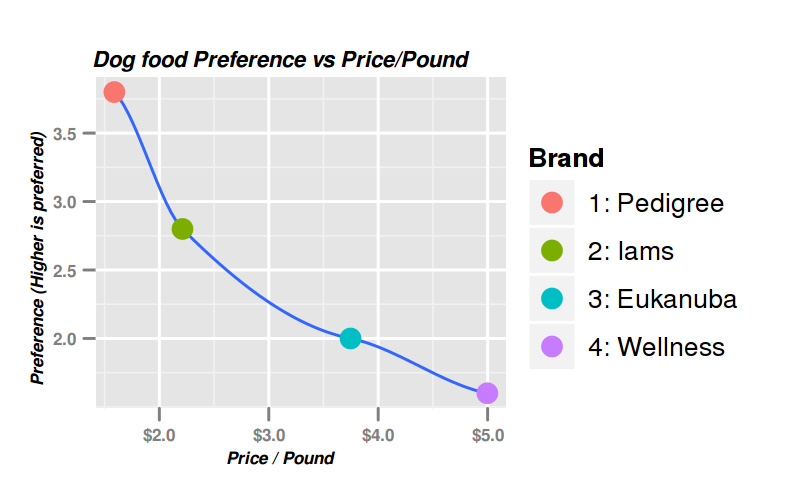
The 1000 word story in a single chart
iv. Conclusions, disclaimers and thoughts
We were surprised by the results and by the consistency our dog demonstrated beyond the experiments despite the states shuffling the order of plates betwixt experiments.We started this experiment with no preconceived notions and no hope for whatsoever specific winner. We had no stake in any specific result nor any preference for whatever of the foods we tried.
To brand the results more statistically significant, we should take done a larger number of experiments, but we prefer the Bayesian approach (equally opposed to frequentist arroyo) to statistics. Given what we knew, at a certain point the results were just likewise obvious and consistent for us, so we stopped. Julie has told us in no ambiguous terms what her preferences are. (see this example for the example of "low N, potent effect, strong back up")
We welcome any criticism and suggestions for improvements. We also encourage other people to run their own experiments, with more brands of nutrient, and publish them on the spider web.
The experiment doesn't say which food is healthier. It only tells us which one is preferred by the canis familiaris herself.
Here are some of our observations:
- Dogs (at to the lowest degree our dog) are non impressed by pricier items
- In appears that dogs -- similar homo beings -- like junk food, which happens to be cheaper, but not necessarily healthier.
- Our lab didn't follow the social club of the plates. She sometimes skipped plates and returned later to them.
- Our lab didn't starting time at a consistent indicate. Sometimes she started from the leftmost plate, sometimes from the rightmost, and sometimes (albeit less oft) from the center.
Other thoughts
Dogs sense of odour is known to exist much amend than that of humans. According to Wikipedia, information technology has been estimated that dogs, in general, accept an olfactory sense ranging from one hundred thousand to one million times more sensitive than a human's. In some canis familiaris breeds, such equally bloodhounds, the olfactory sense may exist upwardly to 100 1000000 times greater than a man'south.The sense of smell seems to have taken a major part in our Dog's decision to follow an order. Julie has very poor centre-sight and she ever sniffs her food before she eats.
five. Charting Code (R/ggplot source)
#!/usr/bin/r -pi # # script to generate chart for canis familiaris-food experiment # # -- where to look for R libraries .libPaths(c('~/local/lib/R', '/usr/lib/R/library', '/usr/lib/R/site-library' )) # # crave needed libraries: # suppressPackageStartupMessages(library(ggplot2)) # for engagement breaks/formatting functions suppressPackageStartupMessages(library(scales)) # # Graphical constants # Default chart width and peak, resolution, font-size # (ggplot saves also big files past default) # golden.ratio = 1.61803399887 W = four.0 H = W / golden.ratio DPI = 200 FONTSIZE=eight # # Theme definitions # title.theme = theme_text(family="FreeSans", face="assuming.italic", size=FONTSIZE) y.label.theme = theme_text(family="FreeSans", face="bold.italic", size=FONTSIZE-2, angle=90) 10.label.theme = theme_text(family="FreeSans", face="bold.italic", size=FONTSIZE-2) x.axis.theme = theme_text(family="FreeSans", face="assuming", size=FONTSIZE-two, colour="grey50") y.axis.theme = theme_text(family unit="FreeSans", face up="bold", size=FONTSIZE-two, colour="grey50") # # generate_chart # Generic office to generate one (Y = f(time)) time-serial nautical chart # with a LOESS smoothed line, and monthly 10-axis labeling # generate_chart <- office( data=d, x, y, title='The title', ylab='The Y-centrality label', xlab='The X-centrality label', file='thechart.png' ) { the.aes <- eval(substitute(aes(10, y), list(10 = substitute(x), y = substitute(y)))) ggplot(data=d, the.aes) + geom_smooth(method='loess') + geom_point(aes(color=Brand), pch=20, cex=5) + opts(title=title, plot.title=title.theme, axis.title.y=y.label.theme, axis.championship.10=10.characterization.theme, axis.text.ten=x.axis.theme, axis.text.y=y.axis.theme ) + scale_x_continuous(xlab, breaks=c(ane,2,3,iv,5), labels=c('$1.0','$2.0','$iii.0','$four.0','$v.0')) + scale_y_continuous(ylab, breaks=c(two.0,2.5,3.0,three.5,4.0), labels=c('2.0','ii.5','iii.0','3.5','4.0')) ggsave(file=file, width=West, meridian=H, dpi=DPI) } # # main # if (! exists('argv') || is.null(argv) || (length(argv) < 1)) { argv <- c('dogpref.csv') } csvfile <- argv[1] # # -- read the CSV data into data-frame 'd' # d <- read.csv(csvfile, h=T) # # Summate new columns from existing ones and convert date blazon # d <- transform(d, price.per.pound=cost/weight ) # # Generate the price-per-pound vs dog-preference nautical chart # generate_chart( data=d, x=price.per.pound, y=preference, title='Dog food Preference vs Cost/Pound', ylab='Preference (College is preferred)', xlab='Cost / Pound', file='dogpref.png' ) warnings() R (littler) lawmaking to generate the in a higher place chart
Source: https://www.yendor.com/julie/DogFood/
Posted by: martinposere88.blogspot.com

0 Response to "Which Kind Of Food Do Dogs (Or Any Animal) Prefer Best Science Fair Project"
Post a Comment